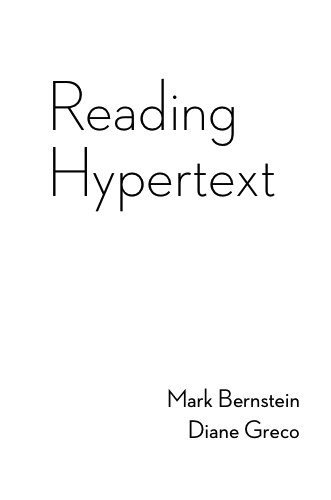Dangerous Readings
Stacey Mason

HTLit spent the weekend at MIT for the second international Web Art Science Camp, Dangerous Readings.
We weren’t entirely sure what to expect, and initially tried to closely model E-LitCamp. However, the group was very active and participatory, and the space was very good for fostering more informal discussion. Influenced by Alan Dix’s description of Tiree Tech Wave, it soon became clear that enforcing a session structure would only dissuade productive conversations.
The weekend opened with Bill Bly’s excellent presentation of We Descend Volume 2, which set the tone for interesting discussion that continued through the weekend. Bly’s demo confirmed that hypertext literature has indeed come a long way from the StorySpace works of old, while still embodying the very essence of hypertext literature. The text, like the first volume, is very much exploratory, and the spatial relationships of the interface encouraged an excellent discussion of authorial process—should form follow content or vice versa?—that became a recurrent theme throughout the weekend. It also raised questions of what should be shown to the reader, which bits of text are reserved for the author’s personal notes; if hypertext affords some overlap, how does it shape the work?
MIT’s Angela Chang demoed an interactive iPad narrative for children that encourages parent-child reading and interaction. The work met much adoration from the group, and spawned an interesting of how interactive narratives and interfaces encourage different reading and thought patterns, particularly in young children. Chang explained that children were able to recognize a relationship between text and meaning from a much younger age while engaging with the work.
Jonathan Brandl and Nick Apostolides starred in a dramatic reading of Mark Bernstein’s hyperdrama The Trojan Girls, an interesting spin on The Trojan Women that takes place in the not-so-distant future during the second American Civil War. The work argues that hypertextual recombination of dramatic dialogue can yield identical plots while changing other facets of the text (adding subtext, changing inter-character relations, etc). A fruitful discussion followed the reading, which examined the nature of reordering plot events and the relationship of constraints and narrative building.
Remix aesthetics and cross-media adaptation were recurring themes of discussion, seen in informal presentations of Meanwhile for iOS, Steve Meilleux’s 100 Days work, and The Trojan Girls. A reader takes a unique pleasure in recognizing familiar elements in a remixed work—discovering and recognizing implicit links—and there was much discussion over how much an understanding of context adds to a work. Other recurring themes included publishing models, sources for new work, the role of the institution in fostering creation, the value of criticism, and anticipating reader experience in the writing process.
The weekend was very successful and, personally, very helpful for clarifying and focusing ideas for future research. Huge thanks to Eastgate and MIT’s Comparative Media Studies and Writing and Humanistic Studies programs for sponsoring what was ultimately a very productive and engaging weekend.
Twitter archives are available, as is a trip report by Andrew Plotkin.
